In the ever-evolving world of digital marketing, understanding how your website performs is crucial for success.
Whether you’re a CRO expert, an A/B testing enthusiast, or a marketer aiming to maximize online impact, conducting website analysis is a fundamental skill that can reveal valuable insights and drive effective strategies.
It goes beyond numbers and metrics; it unveils the hidden story behind user behavior, uncovers potential bottlenecks, and highlights optimization opportunities.
As digital landscapes become increasingly competitive, the significance of a well-executed website analysis cannot be underestimated.
Let’s get into it.
What is Website Analysis?

Website analysis is the process of dissecting and evaluating a website’s performance in terms of speed, user experience, traffic, and search engine optimization.
It involves diving deep into the data and metrics that reveal how your website functions, how users interact with it, and where opportunities for improvement lie.
The purpose of website analysis is simple yet powerful: to uncover the truth about your website’s performance and user experience.
Why It’s Important To Conduct Website Analysis
Website analysis is not just a routine task—it’s a crucial component of your digital strategy that can propel your online success. It’s a process that examines your website’s performance, user experience, and effectiveness.
Research shows that users judge a company’s credibility within milliseconds of landing on its website. If your site fails to impress within that fleeting moment, you risk losing potential customers.
A study by Adobe revealed that 38% of website visitors will stop engaging with a website if the content or layout is unattractive.
This is where website analysis comes into play as a powerful tool to help you optimize your website so that it’s not just another site in the long list of sites adding contributing to negative user experience.
Let’s look at some important reasons you should conduct a website analysis.
- Website analysis allows you to uncover areas for improvement and optimize your website’s performance.
- It helps you understand and serve your target audience better
- You can also uncover usability issues and enhance user experience
- Website analysis allows you to identify conversion barriers and provide you with insights on how to resolve these barriers and optimize conversion rates
Important Factors To Consider Before Running Website Analysis
Before diving headfirst into website analysis, it’s crucial to establish a solid foundation. Considering these important factors will ensure your analysis is focused, insightful, and aligned with your business objectives.
Let’s explore the key factors you need to consider:
-
Goals and Objectives
Clearly defining your goals and objectives is the starting point for any successful website analysis.
Ask yourself: What do you aim to achieve with your website? Is it to increase conversions, boost engagement, improve search rankings, or all of the above?
When you set specific and measurable goals, you can tailor your analysis to track the most important metrics.
-
Key Performance Indicators
Identifying the right KPIs is essential for tracking your website’s performance effectively.
Depending on your goals, KPIs can include metrics such as conversion rate, bounce rate, average session duration, organic search traffic, or social media engagement.
Select KPIs that align with your objectives and provide actionable insights into your website’s success.
-
Target Audience
Understanding your target audience is paramount when analyzing website performance. Consider segmenting your audience based on demographics, interests, or behavior patterns.
This segmentation allows you to gain deeper insights into specific user groups, tailor your analysis to their needs, and optimize your website accordingly.
-
Data Availability
Take stock of the data you have at your disposal. Analyzing historical data, whether qualitative or quantitative data, can provide valuable insights into trends and patterns, while real-time data offers a snapshot of your website’s current performance.
Identify the data sources available, such as Google Analytics, heatmaps, user surveys, and ensure you have access to the data you need for a comprehensive analysis.
-
Tools and Available Resources
Choosing the right tools and resources is instrumental in conducting an effective website analysis.
Many options are available, from web analytics platforms like Google Analytics and heat mapping tools like FigPii to user testing software and SEO tools.
Evaluate your needs, budget, and expertise to select the tools that best align with your analysis goals.
Types of Website Analysis and How To Run Them
Website analysis is a multifaceted process that empowers you to understand, evaluate, and optimize the performance of your website.
In this section, we will explore different types of website analysis and provide practical insights on how to run them effectively.
-
Performance Analysis
According to Google, 53% of mobile site visitors will leave a page that takes longer than 3 seconds to load.
Regarding website analysis, one of the critical areas to focus on is performance. Slow-loading websites and poor mobile responsiveness can lead to high bounce rates and frustrated users.
Here are some essential steps to run a performance analysis:
-
Measure Page Load Speed
Utilize tools like Google PageSpeed Insights or GTmetrix to assess your website’s page load speed. Identify performance bottlenecks, such as large image sizes or excessive server requests,
-
Evaluate Mobile Responsiveness
With mobile usage increasing, ensuring your website provides an optimal experience across devices is crucial.
Test your website on different devices and screen sizes to identify layout or functionality issues.
-
Analyze Website Code, Scripts, and Files
Examine your website’s code, scripts, and files to identify render-blocking resources that can slow down the loading process.
This even becomes worse if the users’ internet connections are poor.
-
Monitor Overall Website Performance
Set up performance monitoring tools, such as Google Analytics or website speed tracking services, to regularly review essential metrics like page load time, time to first byte (TTFB), and server response time.
-
User Experience Analysis
User experience (UX) plays a pivotal role in the success of your website. It directly impacts how users perceive and interact with your site, influencing their engagement.
When conducting user experience analysis, here are the steps you can take:
-
Perform Usability Testing
Conduct usability testing to identify any usability issues or pain points users may encounter.
Engage real users to navigate your website and provide feedback on their experience.
Observe their interactions, note areas of confusion or frustration, and make necessary improvements to enhance usability.
-
Evaluate Navigation and Structure
Assess the navigation and structure of your website to ensure it is intuitive and easy to use. Review the clarity of menu labels, the hierarchy of pages, and the placement of essential elements.
-
Test For Mobile Responsiveness
Test your website on different devices, including smartphones, tablets, and desktops, to identify layout or functionality issues. Make necessary adjustments to optimize the user experience for each device.
-
Conduct Accessibility Tests
Ensure your website is accessible to individuals with disabilities, adhering to Web Content Accessibility Guidelines (WCAG).
Evaluate elements such as color contrast, text alternatives for images, keyboard navigation, and screen reader compatibility.
-
Conversion Analysis
Analyzing conversions is essential for driving business growth and achieving your goals. The goal of conversion analysis is to identify barriers or inefficiencies in the conversion funnel and make data-driven improvements to rectify these issues.
-
Set up Conversion Tracking
Set up conversion tracking to measure and analyze your conversion rates and key actions.
Utilize tools like Google Analytics or other tracking platforms to track and attribute conversions to specific sources, campaigns, or user segments.
This data will provide valuable insights into your conversion performance.
-
Analyze Conversion Metrics
Dive into conversion metrics such as conversion rate, average order value, customer lifetime value, and conversion attribution.
Examine these metrics in relation to different traffic sources, landing pages, and user segments.
This analysis will help you identify which sources, pages, or segments drive the highest conversion for your business.
-
Analyze the Conversion Funnel
Dive into the conversion funnel to identify potential bottlenecks or areas for improvement.
Trace the user journey from the initial touchpoint to the final conversion step. Analyze each step in the funnel to understand where users may drop off or encounter obstacles.
This analysis helps pinpoint areas for optimization and streamlining the conversion process.
-
Implement A/B Testing
Experiment with A/B testing to optimize your conversions. Test different design elements, calls to action (CTAs), messaging, or landing page layouts.
You can determine which elements lead to higher conversion rates by comparing variations.
A/B testing allows you to make data-driven decisions and continuously refine your strategies.
-
Identify Conversion Barriers
Identify any barriers that may hinder conversions. Complex forms, unclear instructions, or lack of trust indicators can discourage users from completing the desired actions.
Simplify forms, provide clear instructions, instill trust through testimonials or security badges, and ensure a seamless user experience throughout the conversion process.
-
Seo Content Analysis
In today’s digital landscape, SEO (Search Engine Optimization) is pivotal in driving organic traffic to your website.
Conducting an SEO analysis is crucial to ensure your website is optimized for search engines, increasing your visibility and attracting valuable visitors.
-
Keyword Audit
Begin your SEO analysis with a comprehensive keyword audit. Evaluate the keywords you’re targeting and identify new opportunities.
Assess their search volume, competition, and relevance to your audience.
-
Technical SEO Audit
Perform a technical SEO audit to ensure your website is optimized for search engine crawling and indexing.
Evaluate factors such as site speed, mobile-friendliness, site architecture, canonical tags, XML sitemaps, and schema markup.
Identify technical issues such as Sitemaps issues, indexability issues, slow page speed, absence of robots.txt file, etc., that may hinder your website’s performance in search engine rankings.
-
Evaluate Relevance and Alignment
Review your content to ensure it aligns with your target audience and serves their needs. Consider the relevance of your content to your target keywords, industry trends, and audience interests.
Assess whether the content addresses common pain points, provides valuable information, and aligns with your brand messaging.
-
Content Analysis
Dive into content analysis to maximize your website’s search visibility. Assess the quality, relevance, and engagement of your content.
Identify opportunities to optimize existing content or create new content that addresses the needs of your target audience.
Leverage keyword research to guide your content creation strategy, focusing on providing valuable and informative content that ranks well in search results.
-
SERP Analysis
SERP analysis, also known as Search Engine Results Page analysis, is a critical component of SEO content analysis.
It involves studying the search engine results pages for specific keywords to understand how search engines display and rank content relevant to those keywords.
SERP analysis allows you to examine the content and strategies of your competitors who are ranking highly for your target keywords. It also helps you grasp the intent behind user searches for specific keywords.
-
Backlink Analysis
Explore backlink analysis to evaluate the quality and quantity of links pointing to your website.
Analyze your backlink profile’s diversity and identify opportunities for acquiring high-quality backlinks.
Monitor for spammy or low-quality links and take appropriate action to disavow them.
Conducting A Website Analysis; Putting Everything Together
Now that we have explored various types of website analysis, it’s time to bring it all together and understand how to conduct a comprehensive website analysis.
-
Define Purpose and Goals
Start by clearly defining the purpose and goals of your website analysis. Determine what specific aspects of your website you want to evaluate and improve. Defining your purpose and goals will provide a clear direction for your analysis.
-
Identify the Type of Analysis
Based on your goals, identify the specific type of analysis that aligns with your objectives.
Refer to the sections we’ve discussed, such as performance analysis, content analysis, etc. Tailor your analysis to focus on the areas that require attention and improvement.
-
Select Appropriate Tools
Choose the right tools to facilitate your analysis. Depending on the type of analysis you’re conducting, various tools are available to aid you in collecting and interpreting data.
-
Conduct Analysis
Begin the analysis process by collecting relevant data and conducting the specific analysis outlined in your plan.
Perform audits, assess metrics, evaluate user behavior, scrutinize content, analyze SEO factors, and dive deep into the specific focus areas for your analysis.
-
Track Progress and Gather Data
Track the progress of your analysis by consistently collecting and monitoring data. Set up tracking mechanisms to measure and record key performance metrics, user interactions, conversion rates, and other relevant data points.
-
Implement lessons learned
Implement the lessons learned from your analysis into actionable strategies and improvements. Apply the insights gained to optimize your website’s performance, refine your content, enhance user experience, fine-tune your SEO strategies, and boost conversions.
Popular Website Analysis Tools
When it comes to website analysis, having the right tools at your disposal can make all the difference. Here are some popular website analysis tools that can help you gather data, gain insights, and optimize your website effectively:
-
Google PageSpeed Insights
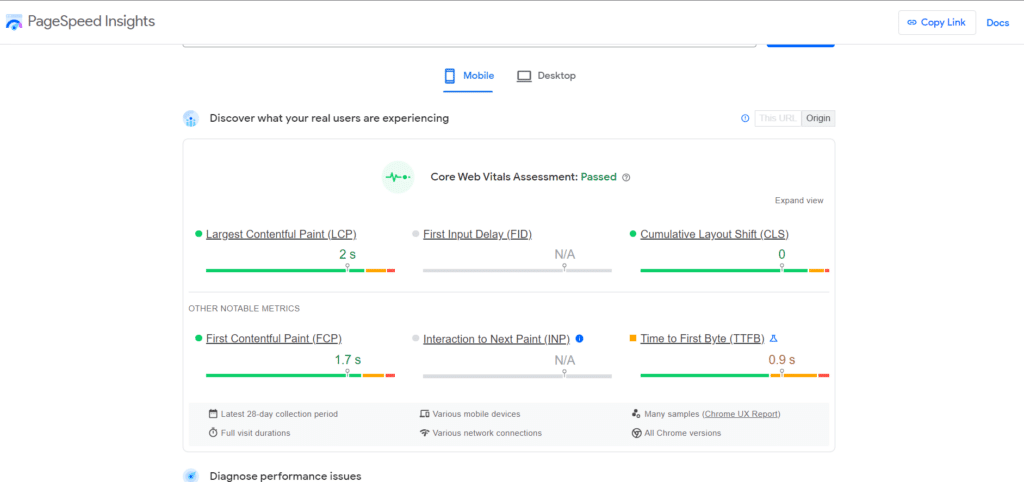
This tool analyzes your website’s performance and provides suggestions for improving page load speed, optimizing images, and minimizing render-blocking resources to enhance user experience and boost search engine rankings.
Use Case: Performance Analysis
-
Google Analytics
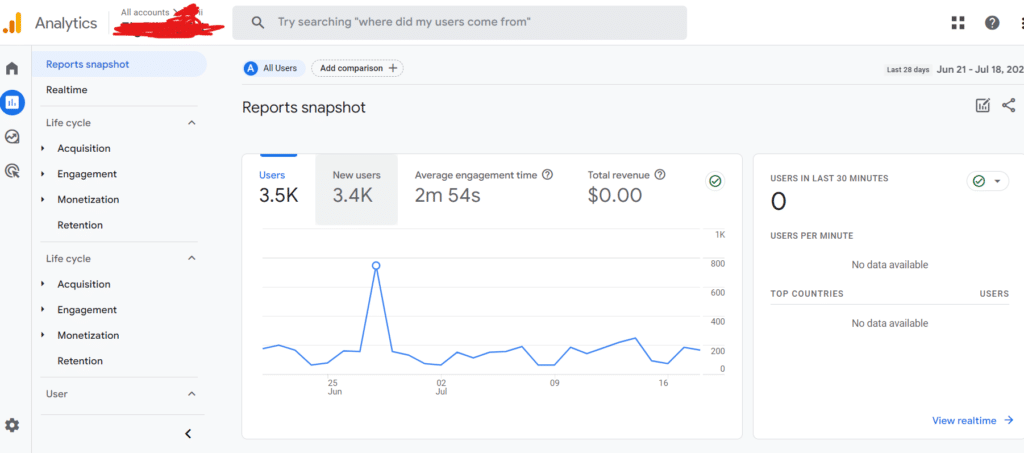
A powerful web analytics tool, Google Analytics tracks website traffic, user behavior, and conversion metrics, allowing you to measure the effectiveness of your marketing campaigns, identify top-performing content, and make data-driven decisions to improve website performance.
Use Cases: SEO Content Analysis, Conversion Analysis
-
Google Search Console
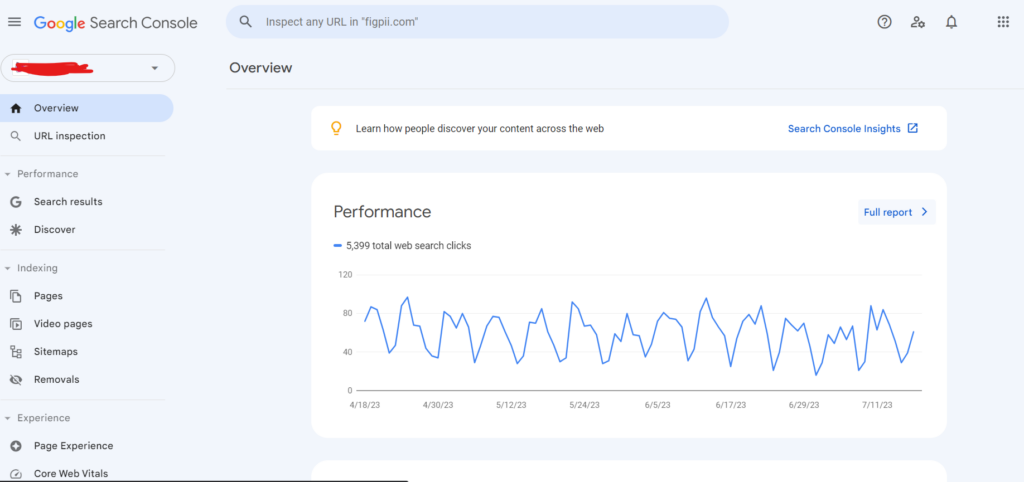
With Google Search Console, you can monitor your website’s presence in Google search results, identify indexing issues, submit sitemaps, and receive important notifications from Google to ensure your website is performing well in search engine rankings.
Use Cases: SEO Analysis, Conversion Analysis.
-
FigPii

FigPii is an all-in-one user feedback and behavior analytics tool. It allows you to collect user feedback through surveys, conduct session replays to understand user behavior, and run A/B tests to optimize conversions and user experience.
Use Cases: User Experience Analysis, Conversion Analysis, Usability Analysis.
-
SemRush
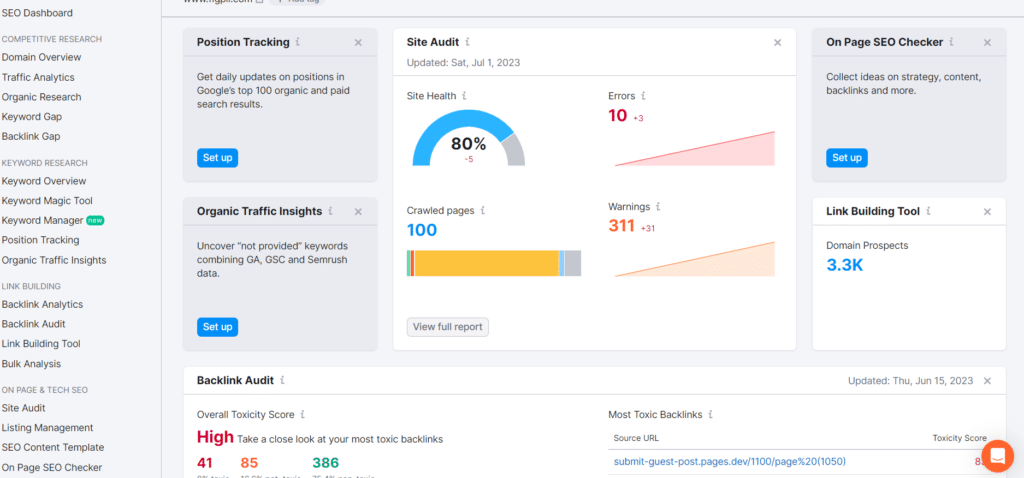
Semrush is a comprehensive SEO and digital marketing toolkit. It provides keyword research, backlink analysis, site audit, competitive research, and other features to help you optimize your website’s visibility, drive traffic, and stay ahead of the competition.
Use Case: SEO Content Analysis.
-
Ahrefs

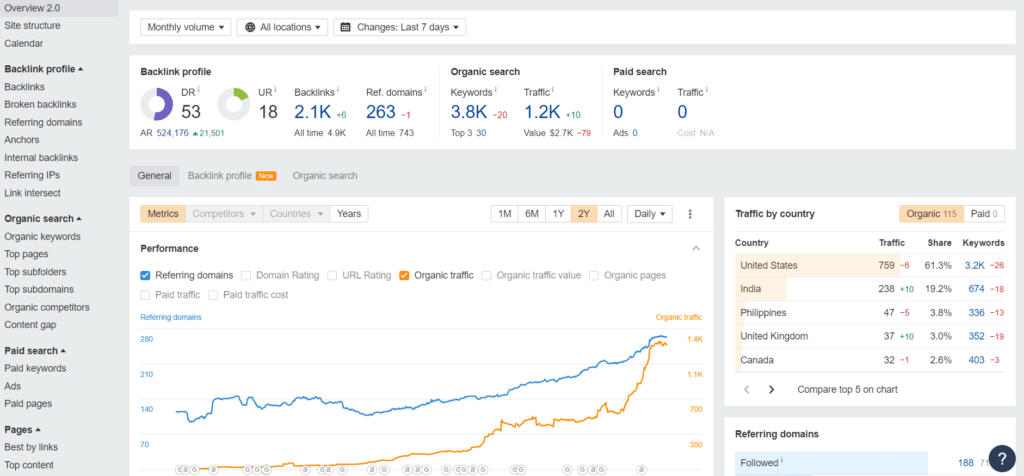
Ahrefs is a powerful SEO toolset that offers features such as keyword research, backlink analysis, content exploration, and rank tracking. It helps you understand your website’s organic search performance, analyze competitors, and optimize your SEO strategy.
Use Case: SEO Content Analysis.
-
Hotjar

Hotjar combines various analytics and feedback tools, including heatmaps, session recordings, surveys, and user feedback polls. It enables you to understand user behavior, visualize user interactions, and gather qualitative insights to enhance usability and user experience.
Use Cases: User Experience Analysis, Conversion Analysis, Usability Analysis.
These popular website analysis tools offer a range of features and functionalities to support your analysis efforts, from performance optimization and user behavior analysis to SEO research and conversion rate optimization.
Conclusion
Website analysis is not a one-time task, but rather an ongoing process that requires dedication, adaptability, and a commitment to continuous improvement.
Remember, each step of the analysis process brings you closer to understanding your audience better, enhancing user experiences, and improving website performance.

